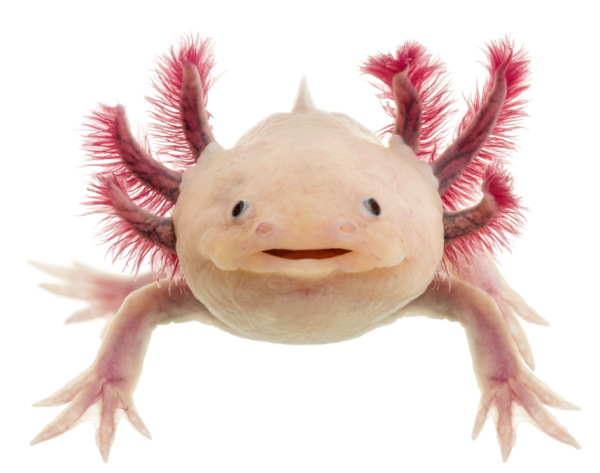Within the lakes of Xochimilco, on the outskirts of Mexico City, lives a truly mind-blowing creature – the axolotl. These wondrous little amphibians have particular unique abilities that make them stand out from the crowd in the animal kingdom. Oh, and they’re also super cute!
The axolotl are also known as the “Mexican walking fish”, even though they aren’t actually fish. However, unlike their close relatives, the salamander, they do spend their lives permanently under water. They have been the subject of fascination throughout history, and from the beginning they have been steeped in legend. The Aztec gods were said to willingly sacrifice themselves in order to yield in battle, but there was one god, Xolotl, who didn’t want to prematurely end his life. In order to avoid this dreadful fate, he shape-shifted numerous times until he took the form of the axolotl. Once the other Aztec gods discovered this, Xolotl’s punishment was to forever live under the murky depths of the water as this “water monster”.

The inspiration for this myth may be that the axolotl possesses a seemingly god-like ability. Their capability for regeneration has been a cause for much attention amongst scientific researchers, healers, and pet owners alike. They can regenerate limbs, jaws, spines, tails, skin, and even their brains. This is an unlimited ability – but I certainly wouldn’t advise buying one as a pet just to try it out, that’s very cruel.
Alongside the regeneration that they possess in themselves, scientists are even able to use cells from one axolotl to create regeneration on another. For example, if you took cells from a green axolotl’s leg, you could plant these onto a white axolotl and it would begin to grow a green leg. It would certainly be an ethically questionable practice now, but in the late ‘60s, scientists even planted a second head onto the back of one axolotl, and it managed to live like this for a few months. This is why these animals are so widely used within the research community; it is believed that these creatures could hold the key to humans possessing these abilities too. This could be beneficial for amputees, burn victims, and allow humans to grow back organs. The axolotl is also 1000 times more resistant to cancer than any other animal, so it is understandable why extensive research is done with them.
What also defines the axolotl as unique is the neoteny. This means that the axolotl doesn’t go through metamorphosis into adulthood and keeps all of its juvenile features, such as their dorsal fins and gills. Other salamanders grow out of their dorsal fins, and when they move onto land in adulthood, they lose their gills. This is what makes them look especially cute and what makes them such a popular aquatic pet – just look at that smile!
It is very disheartening to hear that these adorable animals are on the brink of extinction in the wild. In 1998 there were 6000 per square kilometre in the lakes and canals of the Xochimilco region, but as of 2014 there were just 36 per square kilometre. It is believed that at this rate, the axolotl will be extinct in the wild by 2025, unless action is taken. This drastic decline in recent years has been caused by numerous factors, including pollution from chemical contamination, introduction of non-native species such as fish including the tilapia and mojarra, and also the consumption of roasted axolotl (considered a delicacy in Mexico). There is a strong correlation between the rise in population of Mexico City and the decline in population of axolotl. Even as far back as the 1860s, one of the two lakes that the axolotl was exclusively home to was drained by land speculators and used to build on for the expansion of Mexico City.
However, not all hope is lost. Various conservation efforts are being set in place to revive the wild population by releasing captive axolotl back into the wild. It is not only research centres and zoos that are offering their aid – nuns are too! The Sisters of the Monastery of the Dominican Order, located close to Lake Patzcuaro, are assisting these efforts by repopulating the “achoques” in the wild, a very close relative to the axolotl. They have been familiar with the animal for a long time, as they believe the achoque holds restorative powers, and they make a syrup from the animal that is used to help lung ailments such as coughs, asthma, and too much phlegm. Their affinity to the salamander has made them experts, and they are believed to be the first religious community to be involved with amphibian conservation. They are exceptionally good at breeding healthy salamanders – unlike in standard laboratories where there is a big problem with inbreeding.
All animals play a vital role on the earth, and axolotls and achoques are essential to the biodiversity of their local habits. They also play a vital role in Mexican culture. Since the Aztec god Xolotl transformed into the salamander, the creatures have been mythologised and their iconic status reverberates within the local and national community. The axolotl can regenerate its own limbs, but it cannot solely regenerate its wild population – and that is where we can all help.







